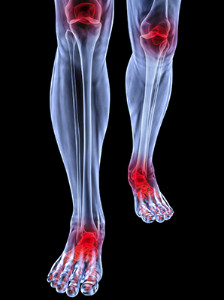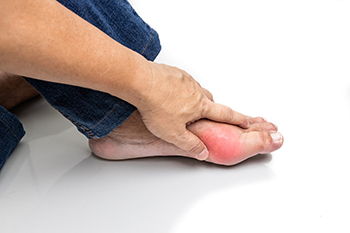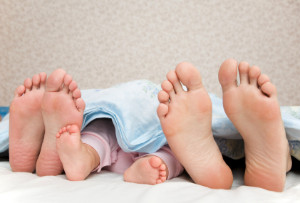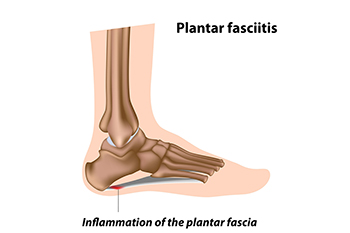August 2022
An Ankle Sprain Can Happen to Anyone

Many people who participate in sports activities experience ankle sprains, although this type of injury is not limited to this particular group of people. Patients from all walks of life that range from being physically fit to having limited exercise experience can incur an ankle sprain. Research has shown the ankle is a common joint that can be injured, and it is often the result of twisting the ankle beyond its normal range of motion. This can happen from stepping off of a curb unexpectedly, or from walking or running on uneven surfaces. Additionally, it can occur from landing improperly on the foot after jumping, or from having endured a fall. An ankle sprain is divided into three classes, consisting of a grade one, two, or three ankle sprain. A mild sprain can be categorized into the grade one class, and there is generally no disability that accompanies this type of sprain. A grade two sprain can cause pain and discomfort, and there may be a slight tear of one or more of the ligaments. The approximate time for a full recovery is six weeks or less. A severe ankle sprain can fall into the grade three class, and often involves a complete tear. This type of sprain can take up to three months to completely heal. If you have endured an ankle sprain, please consult with a podiatrist who can categorize the sprain, and offer correct treatment options.
Ankle sprains are common but need immediate attention. If you need your feet checked, contact John Horlebein, DPM from Northern Cascades Foot & Ankle, LLC. Our doctor can provide the care you need to keep you pain-free and on your feet.
How Does an Ankle Sprain Occur?
Ankle sprains take place when the ligaments in your ankle are torn or stretched beyond their limits. There are multiple ways that the ankle can become injured, including twisting or rolling over onto your ankle, putting undue stress on it, or causing trauma to the ankle itself.
What Are the Symptoms?
- Mild to moderate bruising
- Limited mobility
- Swelling
- Discoloration of the skin (depending on severity)
Preventing a Sprain
- Wearing appropriate shoes for the occasion
- Stretching before exercises and sports
- Knowing your limits
Treatment of a Sprain
Treatment of a sprain depends on the severity. Many times, people are told to rest and remain off their feet completely, while others are given an air cast. If the sprain is very severe, surgery may be required.
If you have suffered an ankle sprain previously, you may want to consider additional support such as a brace and regular exercises to strengthen the ankle.
If you have any questions please feel free to contact our office located in Chelan, WA . We offer the newest diagnostic and treatment technologies for all your foot and ankle needs.
How to Care For Arthritic Feet

Arthritis can cause a lot of pain and discomfort in your feet. Walking and standing might be uncomfortable due to problems with your heels, ball of foot, ankle, or toes. There are various things you can do to attempt to lessen your pain. Feet need circulation, especially if you have arthritis. This requires that you keep blood moving through them – by walking, taking warm foot baths, getting foot massages, and raising your feet when reclining. Examine your feet for bumps, sores, or discolored areas and monitor any changes in how your feet feel. Avoid bad habits, such as wearing ill-fitting shoes, sitting too long without stretching, smoking, and exposing your feet to cold temperatures. Wear warm socks and comfortable padded shoes in colder months. Do not ignore problems with your feet as you could be putting them at risk of more injury. If you have arthritis and notice problems with your feet, make an appointment with a podiatrist who can diagnose and provide treatment options for you.
Arthritis can be a difficult condition to live with. If you are seeking treatment, contact John Horlebein, DPM from Northern Cascades Foot & Ankle, LLC. Our doctor can provide the care you need to keep you pain-free and on your feet.
Arthritic Foot Care
Arthritis is a term that is commonly used to describe joint pain. The condition itself can occur to anyone of any age, race, or gender, and there are over 100 types of it. Nevertheless, arthritis is more commonly found in women compared to men, and it is also more prevalent in those who are overweight. The causes of arthritis vary depending on which type of arthritis you have. Osteoarthritis for example, is often caused by injury, while rheumatoid arthritis is caused by a misdirected immune system.
Symptoms
- Swelling
- Pain
- Stiffness
- Decreased Range of Motion
Arthritic symptoms range in severity, and they may come and go. Some symptoms stay the same for several years but could potentially get worse with time. Severe cases of arthritis can prevent its sufferers from performing daily activities and make walking difficult.
Risk Factors
- Occupation – Occupations requiring repetitive knee movements have been linked to osteoarthritis
- Obesity – Excess weight can contribute to osteoarthritis development
- Infection – Microbial agents can infect the joints and trigger arthritis
- Joint Injuries – Damage to joints may lead to osteoarthritis
- Age – Risk increases with age
- Gender –Most types are more common in women
- Genetics – Arthritis can be hereditary
If you suspect your arthritis is affecting your feet, it is crucial that you see a podiatrist immediately. Your doctor will be able to address your specific case and help you decide which treatment method is best for you.
If you have any questions, please feel free to contact our office located in Chelan, WA . We offer the newest diagnostic and treatment technologies for all your foot care needs.
Causes and Symptoms of Gout

Gout is a common form of inflammatory arthritis that can be extremely painful. It generally attacks a joint in the body, frequently the big toe. The joint becomes inflamed during what is termed a flare-up. Usually the inflammation recedes after a few days or a week. Symptoms of gout are pain, redness, swelling, tenderness to touch, and heat. Men are more likely to have gout than women. Obesity, genetics, high blood pressure, consuming high levels of alcohol, and eating foods rich in purines are risk factors. Purines are contained in red meat, organ meat, and some seafood. The purines break down into uric acid, which then can crystallize in the joint and result in inflammation. While there is not a cure for gout, it can be treated. If you have frequent problems with gout in the big toe, please see a podiatrist for more information and possible treatment options.
Gout is a foot condition that requires certain treatment and care. If you are seeking treatment, contact John Horlebein, DPM from Northern Cascades Foot & Ankle, LLC. Our doctor will treat your foot and ankle needs.
What Is Gout?
Gout is a type of arthritis caused by a buildup of uric acid in the bloodstream. It often develops in the foot, especially the big toe area, although it can manifest in other parts of the body as well. Gout can make walking and standing very painful and is especially common in diabetics and the obese.
People typically get gout because of a poor diet. Genetic predisposition is also a factor. The children of parents who have had gout frequently have a chance of developing it themselves.
Gout can easily be identified by redness and inflammation of the big toe and the surrounding areas of the foot. Other symptoms include extreme fatigue, joint pain, and running high fevers. Sometimes corticosteroid drugs can be prescribed to treat gout, but the best way to combat this disease is to get more exercise and eat a better diet.
If you have any questions please feel free to contact our office located in Chelan, WA . We offer the newest diagnostic and treatment technologies for all your foot and ankle needs.
How to Care For Children’s Feet

If you care for your children’s feet as they grow, this can help protect them from having problems with their feet as adults. Practicing a regular routine when it comes to caring for children’s feet is similar to what is recommended for adults. Wash your child’s feet every day, dry them carefully, and apply a bit of baby powder to keep them healthy. Buy them shoes that fit right – whether they are at the soft or hard shoe stage. Make sure that the shoes have enough room in the foot box for the toes to grow. Use socks made of cotton or wool and that fit properly without pinching your child’s feet. Cut their toenails in a straight line so that they do not develop ingrown toenails. Allow your children to go barefoot around the house so that their feet will develop and gain strength without being restricted. If questions or problems arise related to your children’s feet, consult with a podiatrist, an expert in this area.
The health of a child’s feet is vital to their overall well-being. If you have any questions regarding foot health, contact John Horlebein, DPM of Northern Cascades Foot & Ankle, LLC. Our doctor can provide the care you need to keep you pain-free and on your feet.
Tips for Keeping Children's Feet Healthy
- Make sure their shoes fit properly
- Look for any signs of in-toeing or out-toeing
- Check to see if they have Clubfoot (condition that affects your child’s foot and ankle, twisting the heel and toes inward) which is one of the most common nonmajor birth defects.
- Lightly cover your baby’s feet (Tight covers may keep your baby from moving their feet freely, and could prevent normal development)
- Allow your toddler to go shoeless (Shoes can be restricting for a young child’s foot)
- Cut toenails straight across to avoid ingrown toenails
- Keep your child’s foot clean and dry
- Cover cuts and scrapes. Wash any scratches with soap and water and cover them with a bandage until they’ve healed.
If you have any questions, please feel free to contact our office located in Chelan, WA . We offer the newest diagnostic and treatment technologies for all your foot care needs.
Why Live with Pain and Numbness in Your Feet?
Plantar Fasciitis in Children

If you are the parent of growing children, then you surely know the importance of looking after their health to make sure that they mature into healthy, vibrant young adults. When they complain about pain in their feet, therefore, you might take these complaints seriously. Some children often experience some kind of heel pain, typically from overuse or an underlying condition or injury. Although there are many potential causes of heel pain in a child, one of the most common overuse injuries that might be causing pain is known as plantar fasciitis. This condition primarily affects the plantar fascia, the tissue that runs from the heel to the bottom of the toes. Children who suffer from plantar fasciitis will sometimes experience pain most prominently when walking at the beginning of the day. This condition can occur from excessive strain put on the feet through sports and other physical activities, or simply from wearing footwear that provides inadequate support and cushioning. Living with plantar fasciitis can be quite uncomfortable. If your child is involved in a sport, it might be very difficult for them to be able to painlessly continue to play if the condition is left untreated. If your child is complaining about heel pain, consider taking them to the podiatrist who can determine if they are suffering from plantar fasciitis or some other kind of condition.
Plantar fasciitis can be very painful and inconvenient. If you are experiencing heel pain or symptoms of plantar fasciitis, contact John Horlebein, DPM from Northern Cascades Foot & Ankle, LLC. Our doctor can provide the care you need to keep you pain-free and on your feet.
What Is Plantar Fasciitis?
Plantar fasciitis is the inflammation of the thick band of tissue that runs along the bottom of your foot, known as the plantar fascia, and causes mild to severe heel pain.
What Causes Plantar Fasciitis?
- Excessive running
- Non-supportive shoes
- Overpronation
- Repeated stretching and tearing of the plantar fascia
How Can It Be Treated?
- Conservative measures – anti-inflammatories, ice packs, stretching exercises, physical therapy, orthotic devices
- Shockwave therapy – sound waves are sent to the affected area to facilitate healing and are usually used for chronic cases of plantar fasciitis
- Surgery – usually only used as a last resort when all else fails. The plantar fascia can be surgically detached from the heel
While very treatable, plantar fasciitis is definitely not something that should be ignored. Especially in severe cases, speaking to your doctor right away is highly recommended to avoid complications and severe heel pain. Your podiatrist can work with you to provide the appropriate treatment options tailored to your condition.
If you have any questions please feel free to contact our office located in Chelan, WA . We offer the newest diagnostic and treatment technologies for all your foot and ankle needs.







